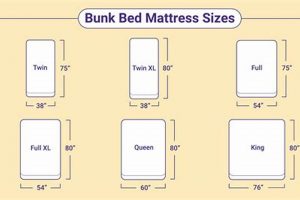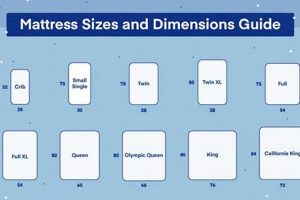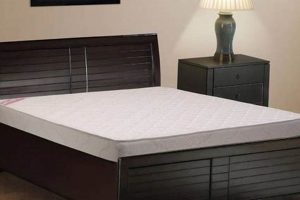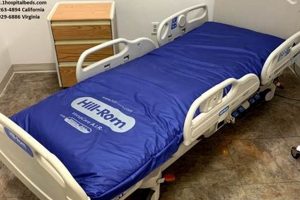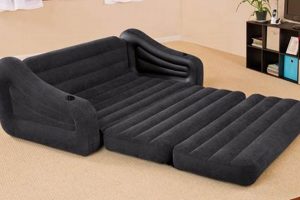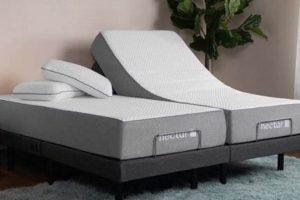The component designed to provide a sleeping surface within a convertible couch structure, generally constructed from foam, innerspring, or a hybrid of materials, allows the furniture piece to function as both seating and a temporary bed. These components vary in size, thickness, and material composition to accommodate different sofa bed mechanisms and user preferences.
Its role is multifaceted. It directly influences the comfort and support experienced during sleep, affecting spinal alignment and overall rest quality. Historically, these sleep surfaces were often an afterthought in convertible furniture design, prioritizing ease of storage over ergonomic considerations. Modern designs, however, increasingly emphasize the need for a comfortable and supportive sleep experience, leading to advancements in materials and construction techniques. The impact of a high-quality sleeping surface within convertible furniture extends to guest accommodations, small living spaces, and multi-functional room design.
Considerations when selecting this crucial component encompass dimensions, material composition, support characteristics, and storage capability within the sofa bed mechanism. The subsequent sections will explore these factors in greater detail, providing a comprehensive overview of critical aspects for making an informed purchase.
Selection and Maintenance Guidance
The following recommendations aim to provide clarity in the selection and upkeep, thereby maximizing longevity and user satisfaction.
Tip 1: Measure the Internal Frame. Precise measurements of the sofa bed’s internal frame are crucial prior to purchase. Ensure the selected item corresponds directly with the frame dimensions to prevent improper fit and potential damage to the mechanism.
Tip 2: Prioritize Density Over Thickness. A higher density foam or innerspring structure generally provides superior support and resists compression over time. A thicker, less dense component may lack adequate support and degrade more quickly.
Tip 3: Evaluate Material Breathability. Breathable materials, such as open-cell foam or cotton blends, promote airflow and reduce heat retention during sleep. This can significantly enhance comfort, particularly in warmer climates or for individuals prone to overheating.
Tip 4: Consider Weight Capacity. Adhere strictly to the weight capacity specified by the sofa bed manufacturer. Exceeding this limit can compromise structural integrity and accelerate wear and tear.
Tip 5: Implement Regular Cleaning. Routine cleaning, including vacuuming and spot-cleaning, helps prevent the accumulation of dust, allergens, and stains. Follow the manufacturer’s cleaning instructions to avoid damaging the materials.
Tip 6: Utilize a Protective Cover. Employing a protective cover safeguards against spills, stains, and general wear. This is especially beneficial for households with children or pets.
Tip 7: Rotate Periodically. Rotating the sleeping surface periodically can distribute wear more evenly and prolong its lifespan. This practice is particularly relevant for innerspring designs.
By adhering to these guidelines, the user can expect enhanced comfort, prolonged durability, and overall satisfaction. Careful consideration of these factors contributes significantly to the long-term value and functionality of the convertible furniture.
The subsequent section will address common misconceptions and frequently asked questions related to this component.
1. Dimensions and Fit
The dimensional accuracy and appropriate fit of a sleeping surface within convertible furniture are paramount for optimal functionality and user comfort. Incorrect dimensions can hinder the deployment and retraction of the sofa bed mechanism, leading to damage and reduced lifespan. Careful consideration of specified measurements is therefore essential.
- Length and Width Concordance
The length and width must precisely match the internal frame of the sofa bed. A component that is too long or wide will prevent the unit from closing correctly, potentially damaging the folding mechanism. Conversely, insufficient dimensions will result in gaps and instability, compromising support.
- Thickness Constraints
The thickness must accommodate the folding mechanism’s design. An excessively thick component can impede the folding process, placing undue stress on hinges and supports. Insufficient thickness may lead to discomfort due to inadequate cushioning and support.
- Corner and Edge Profiling
Corner and edge profiling should align with the frame’s internal contours. Sharp or irregular edges can snag or tear the fabric lining of the sofa bed, while improperly rounded corners may cause localized pressure points and discomfort.
- Impact on Mechanism Lifespan
Mismatched dimensions directly impact the longevity of the sofa bed mechanism. Excessive force applied during opening or closing due to an ill-fitting component accelerates wear and tear on hinges, springs, and other moving parts, leading to premature failure.
The interplay between dimensions and fit constitutes a foundational aspect of convertible furniture performance. Accurate measurements and careful selection based on these measurements are crucial to ensure optimal functionality, user comfort, and extended lifespan of the product. Ignoring these parameters can result in compromised sleeping comfort, operational difficulties, and costly repairs.
2. Material Composition
The constituent materials of a sofa bed sleeping surface exert a considerable influence on comfort, support, durability, and overall user experience. The choice of materials directly impacts factors such as temperature regulation, pressure relief, and resistance to compression. For instance, a high-density memory foam core will generally provide superior pressure relief and conform to the body’s contours more effectively than a conventional polyurethane foam core. Similarly, the presence of natural fibers like cotton or wool in the ticking (outer covering) can enhance breathability and reduce the likelihood of overheating during sleep. The structural integrity and long-term performance are also intrinsically linked to the materials employed, with higher-quality materials exhibiting greater resistance to sagging and deformation over time. Consider a scenario where two seemingly identical sofa beds are offered: one utilizes a low-density foam with a polyester cover, while the other features a high-density latex core with an organic cotton cover. The latter, despite potentially higher initial cost, is likely to provide a more comfortable and supportive sleep surface, coupled with improved durability and hypoallergenic properties, resulting in a more advantageous long-term
investment.
The selection of appropriate materials also considers the folding and storage requirements inherent to sofa bed designs. Materials must exhibit sufficient flexibility to withstand repeated folding and unfolding without compromising structural integrity. For example, a thick innerspring construction may not be suitable for certain sofa bed mechanisms due to its limited flexibility and potential for damage during folding. Conversely, a thinner foam construction may lack the necessary support for sustained use. Hybrid designs, incorporating layers of different materials such as memory foam and high-density support foam, often represent a compromise between comfort, support, and foldability. Furthermore, materials should be chosen with consideration for potential off-gassing and allergenic properties. Certifications such as OEKO-TEX Standard 100 can provide assurance that materials have been tested for harmful substances and meet established safety standards.
In summary, material composition is a critical determinant of sofa bed sleeping surface performance. Careful evaluation of material properties, considering factors such as density, breathability, flexibility, and potential allergenic effects, is essential for selecting a component that offers optimal comfort, support, and longevity. The interplay between material selection and sofa bed mechanism design should be carefully considered to ensure both functional compatibility and sustained user satisfaction. Ultimately, an informed decision regarding material composition represents a key investment in the overall quality and usability of the convertible furniture.
3. Support and Comfort
The synergy between support characteristics and user comfort represents a pivotal factor in the efficacy of any sleeping surface within a convertible sofa arrangement. A lack of adequate support can lead to spinal misalignment and discomfort, while insufficient comfort may result in restless sleep and a diminished sense of well-being. The following explores the interplay of these characteristics in the context of sofa bed sleeping components.
- Spinal Alignment and Postural Support
Proper spinal alignment is crucial for minimizing stress on vertebral discs and surrounding musculature during sleep. A sleeping surface that sags or lacks sufficient firmness can contribute to poor posture, potentially exacerbating existing back pain or creating new discomfort. The internal structure of the sleeping surface, whether composed of innerspring coils, foam, or a combination thereof, dictates its ability to maintain a neutral spinal position. Examples include zoned support systems that provide targeted reinforcement to specific areas, such as the lumbar region, to prevent excessive sinking and maintain proper alignment. The implications of inadequate postural support extend beyond mere discomfort, potentially leading to chronic pain and impaired sleep quality.
- Pressure Point Relief and Circulation
Prolonged pressure on bony prominences, such as the hips and shoulders, can restrict blood flow and lead to localized discomfort. Materials such as memory foam and latex are designed to conform to the body’s contours, distributing weight more evenly and reducing pressure points. The density and resilience of the materials influence their pressure-relieving capabilities. For instance, a high-density memory foam layer will typically offer superior pressure relief compared to a conventional polyurethane foam layer. The implications of inadequate pressure relief can manifest as tossing and turning during sleep, leading to fragmented sleep patterns and daytime fatigue.
- Surface Firmness and User Preference
The perceived firmness of a sleeping surface is a subjective factor that varies among individuals. Some prefer a firmer surface that provides a sense of stability and resistance, while others favor a softer surface that offers a more plush and conforming feel. The ideal firmness level is influenced by factors such as body weight, sleeping position, and personal preference. It is crucial to select a sleeping surface with a firmness level that aligns with individual needs to promote optimal comfort and relaxation. Misalignment between surface firmness and user preference can lead to discomfort, restlessness, and an overall negative sleep experience.
- Temperature Regulation and Breathability
Temperature regulation is another crucial consideration impacting comfort during sleep. Materials that retain heat can lead to overheating and discomfort, disrupting sleep patterns. Breathable materials, such as open-cell foam and natural fibers, promote airflow and help regulate body temperature. Some sleeping surfaces incorporate cooling technologies, such as gel-infused foam, to further enhance temperature regulation. The ability of a sleeping surface to maintain a comfortable sleeping temperature is critical for promoting restful and uninterrupted sleep.
The foregoing illustrates that the selection of a sleeping component for convertible furniture necessitates a holistic approach, considering the interplay of support and comfort characteristics. The optimal choice is contingent upon individual needs and preferences, with careful attention paid to spinal alignment, pressure relief, surface firmness, and temperature regulation. By prioritizing these factors, users can significantly enhance the quality of their sleep experience and derive maximum benefit from their convertible sofa arrangement.
4. Foldability and Storage
The capacity for efficient folding and compact storage constitutes a defining characteristic of any convertible sofa bed arrangement. The integrated sleeping surface plays a critical role in realizing this functionality, necessitating careful consideration of its design and material properties.
- Material Flexibility and Hinge Stress
The constituent materials directly influence the ease and efficiency of folding. Highly rigid materials, such as thick innerspring constructions, impede the folding process and place undue stress on the sofa bed’s hinges and frame. Conversely, overly flexible materials may lack the necessary support for comfortable sleep. A balanced approach, incorporating materials with appropriate flexibility and resilience, is essential for preserving the mechanism’s integrity and ensuring smooth operation. An example is the utilization of high-density foam with strategically placed flex points to minimize resistance during folding.
- Compression and Volume Reduction
The sleeping surface’s ability to compress effectively during folding directly impacts the overall storage volume required when the sofa bed is in its seating configuration. Materials that exhibit high compressibility, such as memory foam, allow for a more compact folded profile, maximizing available space. In contrast, materials with limited compressibility may result in a bulkier folded form, potentially compromising the aesthetic appeal and usability of the sofa bed. The implementation of vacuum compression techniques during the manufacturing process can further enhance compressibility and reduce storage volume.
- Weight Distribution and Mechanism Load
The distribution of weight within the sleeping surface significantly affects the load placed on the folding mechanism. Uneven weight distribution
can create localized stress points, accelerating wear and tear on hinges, springs, and support structures. A uniformly constructed sleeping surface, with consistent material density and support characteristics, ensures a more balanced weight distribution and minimizes stress on the mechanism. This is particularly relevant in sofa bed designs where the sleeping surface is folded in multiple sections. For example, a sleeping surface with reinforced edges can prevent sagging and maintain uniform support, even after repeated folding. - Protection During Storage
The materials must be durable enough to withstand the stresses of folding and storage without degradation. Materials that are prone to cracking, tearing, or compression set (permanent deformation) will compromise the sleeping surface’s long-term performance. A protective cover or casing can further mitigate the risk of damage during storage, shielding the materials from dust, moisture, and abrasion. The selection of materials with inherent resistance to these degradation factors is crucial for preserving the sleeping surface’s integrity and ensuring its continued functionality.
The interplay between these elements material flexibility, compression characteristics, weight distribution, and protection during storage underscores the critical link between foldability, storage efficiency, and the selection of appropriate materials. By carefully considering these factors, designers and manufacturers can optimize the functionality and longevity of convertible sofa bed arrangements.
5. Durability and Longevity
The sustained utility and cost-effectiveness of a sleeping component designed for convertible furniture hinges significantly on its inherent durability and projected lifespan. These attributes are not merely cosmetic but directly impact the long-term value proposition of the entire sofa bed system.
- Material Resistance to Compression Set
The ability of constituent materials to resist permanent deformation under sustained pressure is a critical determinant of longevity. Compression set, the degree to which a material fails to return to its original thickness after prolonged compression, directly impacts support and comfort. High-density foams and resilient innerspring systems exhibit greater resistance to compression set compared to lower-quality alternatives, thereby maintaining their performance characteristics over extended periods. Instances of substandard materials exhibiting rapid compression set result in sagging and diminished support, necessitating premature replacement.
- Fabric and Seam Strength
The integrity of the outer covering and its associated seams plays a vital role in protecting the internal components from wear and tear. Durable fabrics, such as tightly woven cotton blends or synthetic materials with enhanced abrasion resistance, are less susceptible to tearing and puncture. Reinforced seams, utilizing high-strength threads and robust stitching techniques, prevent unraveling and ensure the cover remains securely attached to the internal structure. Cover failures compromise the structural integrity of the sleeping surface, exposing the internal components to damage and potentially rendering the unit unusable. An example is the difference between a cover with single-stitched seams that may unravel quickly and a cover with double-stitched, reinforced seams that withstands repeated use and folding.
- Resistance to Environmental Degradation
Exposure to environmental factors, such as moisture, sunlight, and temperature fluctuations, can accelerate material degradation and shorten the lifespan of the sleeping component. Materials with inherent resistance to these factors, or those treated with protective coatings, exhibit enhanced durability. For instance, moisture-resistant fabrics prevent mold and mildew growth, while UV-resistant materials prevent fading and brittleness. Prolonged exposure to direct sunlight can degrade foam, causing it to lose its supportiveness. Resistance to environmental degradation is therefore paramount for units located in humid climates or exposed to direct sunlight.
- Structural Integrity of Support System
The internal support system, whether comprising innerspring coils, foam cores, or a hybrid configuration, must maintain its structural integrity under repeated use and stress. High-gauge steel coils and high-density foam cores exhibit greater resistance to sagging and deformation, ensuring consistent support and comfort over time. Substandard support systems, prone to failure or collapse, compromise the overall performance of the sleeping surface, leading to discomfort and reduced lifespan. Inferior coil systems may develop bent or broken coils, leading to uneven support. High-density foam provides consistent support, resists sagging, and contributes to a more durable and long-lasting sleeping component.
The aforementioned facets highlight the multifaceted nature of durability and its direct bearing on the longevity of convertible furniture sleeping components. Careful consideration of these factors during the selection process contributes significantly to maximizing the return on investment and ensuring sustained user satisfaction.
Frequently Asked Questions
The following addresses prevalent inquiries concerning the selection, maintenance, and performance characteristics of sleeping components designed for convertible furniture units.
Question 1: How frequently should the sleeping surface be replaced?
The replacement frequency is contingent upon usage patterns, material quality, and maintenance practices. High-use units employing lower-quality materials may require replacement every 3-5 years. Higher-quality components, subjected to moderate use and proper maintenance, can potentially last 7-10 years or longer.
Question 2: What constitutes proper cleaning protocol?
Cleaning protocol adheres to the manufacturer’s guidelines. Generally, vacuuming on a regular basis and spot-cleaning with a mild detergent solution is recommended. Harsh chemicals or abrasive cleaning agents are to be avoided. Professional cleaning may be necessary for extensive stains or soiling.
Question 3: How does sleeping surface thickness affect comfort?
Thickness is a contributing factor, but not the sole determinant, of comfort. Density and material composition play equally important roles. A thicker, lower-density component may lack adequate support, whereas a thinner, high-density component can provide superior support and pressure relief.
Question 4: Are innerspring or foam sleeping surfaces preferable?
The preference between innerspring and foam is subjective and depends on individual needs. Innerspring units typically offer greater support and airflow, while foam units often provide superior pressure relief and motion isolation. Hybrid designs combine the benefits of both material types.
Question 5: How does weight capacity influence selection?
Adhering to the manufacturer’s specified weight capacity is essential. Exceeding the weight limit can compromise the structural integrity of both the sleeping surface and the folding mechanism, potentially leading to premature failure.
Question 6: What are the indicators of a failing sleeping surface?
Indicators of failure include visible sagging, permanent indentations, uneven support, and persistent discomfort. These symptoms suggest that the materials hav
e degraded and the sleeping surface is no longer providing adequate support.
These responses aim to provide clarity on common queries. Thorough consideration of these points facilitates informed decision-making and optimizes the utilization of convertible furniture.
The subsequent section will present a concluding summary.
mattress for sofa bed
The preceding discourse has elucidated key considerations concerning the selection, utilization, and maintenance of the critical component for convertible furniture. Emphasis has been placed on the interplay between dimensions, material composition, support characteristics, and storage requirements. Furthermore, insights into optimizing durability and addressing common performance-related inquiries have been presented.
A discerning approach to procuring and caring for this essential element remains paramount for ensuring both user satisfaction and the sustained functionality of convertible furniture systems. Continued diligence in researching advancements in material science and ergonomic design will further enhance the efficacy and longevity. The quality significantly impacts the utility and value of adaptable living spaces.


